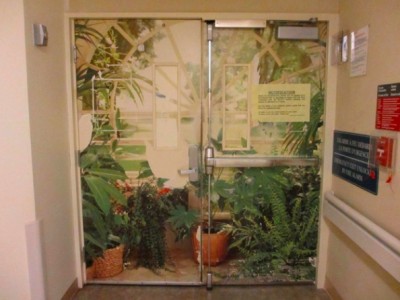
By Anna Tomczak, Department of Health Sciences, Carleton University
For many years the environment has been considered to have important effects on human well-being. Feng shui, for instance, is a Chinese philosophical system that aims to harmonize everyone with the surrounding environment through orientation of buildings and other structures. You might have heard not to align your bed with your door because doors generally have a strong flow of energy that may disrupt sleep. Although the health benefits of orienting your bed in a certain way are debatable, research has found that the surrounding environment does have an effect on both physical and mental health.
Our Aging Brains
As we age, so does our brain. This can lead to a series of irreversible changes that disrupts memory and other cognitive functions. These types of symptoms, when severe enough, are often grouped under the term dementia and include several different diseases, such as Alzheimer’s disease, vascular dementia, and Parkinson’s disease (Butler & Radhakrishnan, 2012). Although dementia is considered an illness of aging, it not only has a major impact on those who have it, but also on their families and on the Canadian health care system. In Canada, it is estimated that there will be over 1,000,000 prevalent cases of dementia by 2038, with a total economic burden of $152.6 billion (Dudgeon, 2010)! The scary part is that there is no known cause of dementia. Several risk factors have been identified as contributors to the disease; however, they only account for part of it. For example, genes play a role in some cases but are thought to be linked to about 5-10% of dementia diagnoses (Dudgeon, 2010). Interestingly, even if an individual is genetically predisposed to a specific form of dementia, some believe that an environmental factor is necessary for the disease to develop (Elbaz, Dufouil & Alpérovitch, 2007). Additionally, there is no cure for dementia – it entails damage to the brain that can be slowed down but cannot be reversed. Available drugs may help with some of the related behavioural changes of dementia, but they cannot reverse the damage. With so little known about the causes of dementia, researchers have turned to the environment—both physical and social—in hopes of finding preventative measures.
The Environment—Built and Unbuilt
 The environment is a broad term for everything natural and human-built that surrounds us – so studying its effects on human health can be difficult. As a result, some researchers focus specifically on the built environment, which is defined as buildings, transportation systems, energy systems, open space, and agricultural lands that make up and support our communities (Toronto Public Health, 2015). However, this definition remains quite general and encompasses many different possibilities. Research on the built environment has focused on air quality, available green space, walkability of certain areas, occupational environments, and even on the design of buildings. One can start to see how these types of environments can affect us physically, whether it is through the development of cardiovascular diseases, obesity, or cancer. However, it may be a bit more difficult to make the connections between these types of built environments and cognitive health outcomes, such as dementia. But in fact, there is evidence that our surrounding environment can influence the development and the progression of such diseases. For example, the built environment also encompasses factors that better allow individuals to interact with one another. Increased social interactions have been shown to reduce the risk of developing dementia, and lessen the symptoms of those who have it.
The environment is a broad term for everything natural and human-built that surrounds us – so studying its effects on human health can be difficult. As a result, some researchers focus specifically on the built environment, which is defined as buildings, transportation systems, energy systems, open space, and agricultural lands that make up and support our communities (Toronto Public Health, 2015). However, this definition remains quite general and encompasses many different possibilities. Research on the built environment has focused on air quality, available green space, walkability of certain areas, occupational environments, and even on the design of buildings. One can start to see how these types of environments can affect us physically, whether it is through the development of cardiovascular diseases, obesity, or cancer. However, it may be a bit more difficult to make the connections between these types of built environments and cognitive health outcomes, such as dementia. But in fact, there is evidence that our surrounding environment can influence the development and the progression of such diseases. For example, the built environment also encompasses factors that better allow individuals to interact with one another. Increased social interactions have been shown to reduce the risk of developing dementia, and lessen the symptoms of those who have it.
An Interdisciplinary Approach: Carleton’s CIHR Meeting
In order to get a better understanding of the relationship between dementia and various facets of the built environment, the Canadian Institutes of Health Research funded Drs. Paul Villeneuve and Renate Ysseldyk to host a two-day workshop. They invited a diverse group of individuals from many different disciplines to come together with the intention to discuss what is known about dementia, social factors, and the built environment, and to identify emerging areas of research. Several themes arose:
Another Strike Against Air Pollution
Very few studies have evaluated the effects of air pollution on dementia, although a small number of studies in animals suggest there may be a link. However, preliminary analyses of data from the Canadian Study of Health and Aging by Dr. Paul Villeneuve and colleagues did just that— his study aims to characterize the associations between long-term exposure to air pollution and the development of dementia, Alzheimer’s disease and cognitive impairment. The study includes 10,263 participants, 65 years of age or older with no initial cognitive problems, who were followed for 10 years with three follow-up periods. A total of 1,460 participants developed dementia, 563 participants developed Alzheimer’s disease and 883 developed cognitive impairment by the end of the 10 year follow-up period. To determine whether air pollution had an effect on the development of these diseases, measures of ground-level fine particulate matter (PM2.5) and Nitrogen Dioxide (NO2) were assigned to each participant using their residential postal code. Initial findings demonstrated positive associations between these measures of outdoor air pollution and developing dementia and Alzheimer’s disease. With each increase of PM2.5 by 10µg/m3, the risk of developing dementia and Alzheimer’s diseases increases by 32% and 17%, respectively. As an annual average in 10 µg/m3 represents, in 2011, the difference between London UK and Ottawa, or Berlin and Montreal (Environment Canada, 2011). The strength of association for these outcomes is similar to widely reported findings between air pollution and cardiovascular disease.
Green Space, Green Space, and More Green Space
 As previously discussed, there is no known cause of dementia; however, there have been several risk factors associated with its development. Both physical activity and social interactions have been identified as potential factors influencing the development of dementia. A moderate level of physical activity has been identified as a protective factor against dementia, especially in those individuals who have some type of genetic predisposition (Canadian Study of Health and Aging, 2002). Likewise, social interactions help build an individual’s sense of social identity and inclusion, resulting in positive effects on health and well-being (Haslam, Haslam, Knight, Gleibs, Ysseldyk, & McCloskey, 2014). Importantly, these factors may interact with green space. Recent studies have indicated that a greater availability of residential green space increases levels of physical activity (McMorris, Villeneuve, Su, & Jerrett, 2015), decreases exposure to air pollution (Marshall, Brauer & Frank, 2009) and provides an environment where social interactions can be upheld (Bennet et al., 2012), suggesting that green space can help decrease the development of dementia and other cognitive impairments.
As previously discussed, there is no known cause of dementia; however, there have been several risk factors associated with its development. Both physical activity and social interactions have been identified as potential factors influencing the development of dementia. A moderate level of physical activity has been identified as a protective factor against dementia, especially in those individuals who have some type of genetic predisposition (Canadian Study of Health and Aging, 2002). Likewise, social interactions help build an individual’s sense of social identity and inclusion, resulting in positive effects on health and well-being (Haslam, Haslam, Knight, Gleibs, Ysseldyk, & McCloskey, 2014). Importantly, these factors may interact with green space. Recent studies have indicated that a greater availability of residential green space increases levels of physical activity (McMorris, Villeneuve, Su, & Jerrett, 2015), decreases exposure to air pollution (Marshall, Brauer & Frank, 2009) and provides an environment where social interactions can be upheld (Bennet et al., 2012), suggesting that green space can help decrease the development of dementia and other cognitive impairments.
Interior Design and Cognitive Health
 There is also some evidence that the design of a care home may have an effect on the development of dementia as well as the quality of life and safety of individuals with dementia. Findings from these studies suggest that small-size units, with a smaller number of residents, are associated with less sadness, better quality of life, and can help residents better orient themselves (Crespo, Hornillos, & Gómez, 2013). Interestingly, designing these spaces does not have to be performed by professional teams – in fact, in an intervention study conducted by Dr. Renate Ysseldyk and colleagues, having residents choose the design of the spaces enhanced their cognitive capabilities to an even greater extent than when staff made those design decisions, along with building their sense of social connectedness (Haslam et al., 2014). Another important feature to consider is safety, especially since individuals with dementia tend to wander – leaving their homes or facilities without knowing where they are or where they are going. To help deter residents from leaving the facility, long-term care facilities can provide unique doorway designs that mask the entrance to deter the residents from leaving (Alzheimer’s Knowledge Exchange, 2010). Likewise, creating special interest areas away from main exits and doors helps keep residents away from these entrances (Alzheimer’s Knowledge Exchange, 2010). Taken together, this research suggests promising avenues for the role of architecture and design, as well as empowering residents in design decisions, that may help prevent or alleviate the symptoms of dementia.
There is also some evidence that the design of a care home may have an effect on the development of dementia as well as the quality of life and safety of individuals with dementia. Findings from these studies suggest that small-size units, with a smaller number of residents, are associated with less sadness, better quality of life, and can help residents better orient themselves (Crespo, Hornillos, & Gómez, 2013). Interestingly, designing these spaces does not have to be performed by professional teams – in fact, in an intervention study conducted by Dr. Renate Ysseldyk and colleagues, having residents choose the design of the spaces enhanced their cognitive capabilities to an even greater extent than when staff made those design decisions, along with building their sense of social connectedness (Haslam et al., 2014). Another important feature to consider is safety, especially since individuals with dementia tend to wander – leaving their homes or facilities without knowing where they are or where they are going. To help deter residents from leaving the facility, long-term care facilities can provide unique doorway designs that mask the entrance to deter the residents from leaving (Alzheimer’s Knowledge Exchange, 2010). Likewise, creating special interest areas away from main exits and doors helps keep residents away from these entrances (Alzheimer’s Knowledge Exchange, 2010). Taken together, this research suggests promising avenues for the role of architecture and design, as well as empowering residents in design decisions, that may help prevent or alleviate the symptoms of dementia.
Where Do We Go From Here?
Clearly the built environment, and the social interactions it can facilitate, plays an important role in shaping our health profile. But we are only at the beginning stages of fully understanding the magnitude it can have on our psychological health and cognitive functioning. This CIHR sponsored workshop was able to identify several emerging research questions. Future studies should consider how the built environment can be designed to enhance the positive social determinants of health and prevent the development of dementia. The meeting brought together a number of experts in these different areas who are interested in working together to do just that. In the meantime, the next time you are in the market for buying a house, keep in mind how the location may affect your health… and who knows, maybe keeping your bed away from the door won’t hurt either.
Based On:
Villeneuve, P., & Ysseldyk, R. (2015). The Built Environments and Dementia: An Interdisciplinary Approach. Workshop. Carleton University, Ottawa, ON, June 19-20, 2015.
Alzeihmer’s Knowledge Exchange. (2010). Retrieved from: http://alzheimersocietyblog.ca/2012/01/do-you-know-what-the-alzheimer-knowledge-exchange-ake-is/.
Bennet, S. A., Yiannakoulias, N., Williams, A. M., & Kitchen, P. (2012). Playground accessibility and neighbourhood social interaction among parents. Social Indicators Research, 108(2), 199-213. doi:10.1007/s11205-012-0062-4
Butler, R., & Radhakrishnan, R. (2012). Dementia. BMJ Clinical Evidence, 2012.
Canadian Study of Health and Aging. (2002). Retrieved from: http://www.csha.ca/.
Crespo, M., Hornillos, C., & Gómez, M. M. (2013). Dementia special care units: A comparison with standard units regarding residents’ profile and care features. International Psychogeriatrics / IPA, 25(12), 2023. doi:10.1017/S1041610213001439
Dudgeon, S., Alzheimer Society of Canada, & RiskAnalytica. (2010). Rising tide: The impact of dementia on Canadian society: A study. Toronto, Ont: Alzheimer Society of Canada.
Elbaz, A., Dufouil, C., & Alpérovitch, A. (2007). Interaction between genes and environment in neurodegenerative diseases. Comptes Rendus – Biologies, 330(4), 318-328. doi:10.1016/j.crvi.2007.02.018
Haslam, C., Haslam, S.A., Knight, C., Gleibs, I., Ysseldyk, R., & McCloskey, L. (2014). We can work it out: Group decision‐making builds social identity and enhances the cognitive performance of care residents. British Journal of Psychology, 105(1), 17-34. doi:10.1111/bjop.12012
Marshall, J. D., Brauer, M., & Frank, L. D. (2009). Healthy neighborhoods: Walkability and air pollution. Environmental Health Perspectives, 117(11), 1752-1759. doi:10.1289/ehp.0900595
McMorris, O., Villeneuve, P. J., Su, J., & Jerrett, M. (2015). Urban greenness and physical activity in a national survey of Canadians. Environmental Research, 137, 94-100. doi:10.1016/j.envres.2014.11.010
Toronto Public Health. (2015). The Built Environment. Retrieved from: http://www1.toronto.ca/wps/portal/contentonly?vgnextoid=d06e23bf6d481410VgnVCM10000071d60f89RCRD.

Follow us on Twitter!